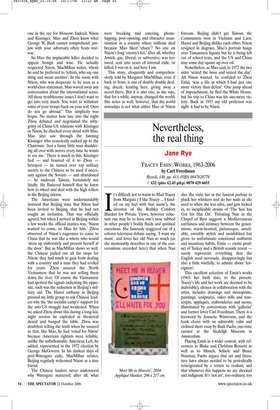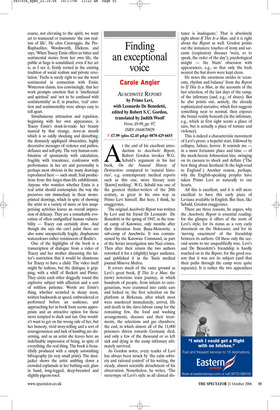Nevertheless, the real thing
Jane Rye
TRACEY EMIN: WORKS, 1963-2006 by Carl Freedman Rizzoli, £40, pp. 413, ISBN 0847828778 ✆ £32 (plus £2.45 p&p) 0870 429 6655 It’s difficult not to warm to Mad Tracey from Margate (‘I like Tracey ... I landed on my feet with that name’), the inventor of the Rothko Comfort Blanket for Private Views, however reluctant one may be to have one’s nose rubbed in other people’s bodily fluids and spiritual excretions. She famously staggered out of a solemn television debate saying, ‘I want my mum’, and loves her old Nan so much (as she memorably describes in one of the conversations recorded here) that when Nan dies she visits her in the funeral parlour to pluck her whiskers and do her nails as she used to when she was alive, and gets locked in, to inexplicable strains of ‘The Sun has Got his Hat On’. Titivating Nan in the Chapel of Rest suggests a Mediterranean earthiness and intimacy between the generations; warm-hearted, picturesque, unreliable, enviably stylish and uninhibited but given to unfortunate emotional outbursts and insanitary habits, Emin — exotic product of Turkey and a British seaside resort surely represents everything that the English used nervously, disapprovingly but also a little wistfully, to admire about ‘foreigners’.
This excellent selection of Emin’s works (1963, her birth date, to the present: Tracey’s life and her work are deemed to be indivisible), chosen in collaboration with the artist, includes drawings and monoprints, paintings, sculptures, video stills and transcripts, appliqués, embroideries and neons, illuminated by converstions with ‘gallerist’ and former lover Carl Freedman. There is a foreword by Jeanette Winterson, and the book closes with an admirably calm and civilised short essay by Rudi Fuchs, one-time curator at the Stedelijk Museum in Amsterdam.
Placing Emin in a wider context, with references to Blake and Christina Rossetti as well as to Munch, Schiele and Bruce Nauman, Fuchs argues that art and literature have always needed to be periodically reinvigorated by a return to realism, and that whenever this happens we are shocked and indignant. It’s ‘not art’, too ordinary, too coarse, not elevating to the spirit; we want art to transcend or transmute ‘the raw realism of life’. He cites Caravaggio, the PreRaphaelites, Wordsworth, Dickens, and says, ‘When Tracey Emin offers us bitter and sentimental stories from her own life, the public at large is scandalised, even if her art is, as I see it, firmly rooted in the existing tradition of social realism and private revelation.’ Fuchs is surely right to use the word sentimental in connection with Emin; Winterson claims, less convincingly, that her work prompts emotion that is ‘intellectual and spiritual’ and ‘not to be confused with sentimentality’ as if, in practice, ‘real’ emotion and sentimentality were always easy to tell apart.
Simultaneous atttraction and repulsion, beginning with her own appearance, is Tracey Emin’s stock-in-trade: her beauty marred by that strange, stove-in mouth which is so oddly shocking and disturbing; the demurely appliquéd obscenities, highly decorative messages of violence and pathos, defiance and self-pity. The very human combination of spontaneity with calculation, fragility with truculence, confession with performance in her art and personality is perhaps most obvious in the many drawings reproduced here — such small, frail productions from this larger-than-life exhibitionist. Anyone who wonders whether Emin is a real artist should contemplate the way she preserves raw immediacy in these monoprinted drawings, which in spite of showing the artist in a variety of more or less unappetising activities leaves an overall impression of delicacy. They are a remarkable evocation of often undignified human vulnerability — Tracey can certainly draw. And though she says she can’t paint there are also some unexpectedly fragile, diaphanous watercolours rather reminiscent of Rodin’s.
One of the highlights of the book is a transcription of dialogue from a video of Tracey and her mother discussing the latter’s conviction that it would be disastrous for Tracey to have a child. The video itself might be tedious, but the dialogue is gripping, with a whiff of Beckett and Pinter. They circle each other doggedly round this explosive subject with affection and a sort of ruthless patience. Words are Emin’s thing, whether scrawled in sleazy neon, written backwards at speed, embroidered or performed before an audience, and approaching her in book form seems appropriate and an attractive option for those more tempted to duck and run. One wouldn’t want to get on the wrong side of her, but her honesty, vivid story-telling and a sort of courageousness and lack of humbug are disarming, and as an artist she leaves here an indefinable impression of being, in spite of everything, the real thing. The book is beautifully produced with a simply astonishing bibiography (in very small print). The dustjacket shows the artist ambling down a crowded esplanade in her bathing-suit, glass in hand, long-legged, deep-breasted and slightly pigeon-toed.



































































































 Previous page
Previous page